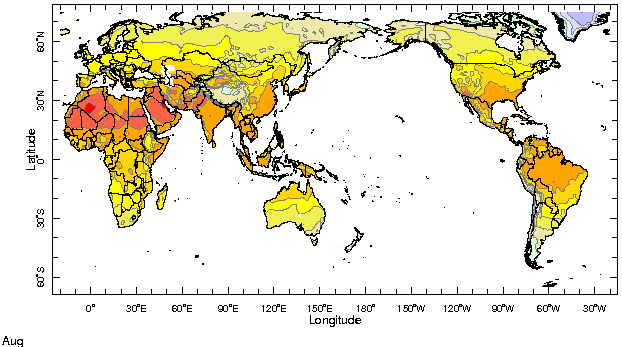|
IRI Climate Digest
September 2001
August Global Climate Summary
Climatological Background
During August, monsoon systems which bring rains to West Africa, South Asia, and southwestern North America have reached their northernmost extent. In the Southern Hemisphere midlatitudes, winter conditions begin to wane by month's end.
Monthly Mean Temperature (1961-1990), data from the Climate Research
Unit, University of East Anglia


Monthly Mean Precipitation (1961-1990), data from the Climate Research
Unit, University of East Anglia


Temperatures
Warmer than average conditions dominated much of the continental landmasses except for Australia.
Europe: Warm conditions continued in Europe, particularly in Northern Italy and along the Adriatic Sea.
Asia: The persistent, unusally warm temperatures across the Central Siberian Uplands and southeast into Mongolia and northern China continued during August, while near average conditions were recorded across the rest of Asia for the month.
Africa: Warmer than average temperatures continued over much of Africa.
Australia: Unusally warm temperatures continued in southern Australia, while the Northern Territory experienced colder than average conditions.
North America: The northern tier of the US and much of Canada experienced warmer than average conditions, including a heat wave that extended from the midwest to the northeast.
South America: Unseasonably warm conditions continued in Northern Argentina and much of Paraguay, with larger values than in July and extending into Uruguay and southern Brazil.
Temperature Difference from the 1961-1990 mean, with data
from NCEP Climate Prediction Center, CAMS.


Precipitation
August precipitation was less than usual over the landmasses of most of the equatorial and subtropical Northern Hemisphere, including a sub-average month for the Indian monsoon, North American monsoon, and African convective zone, and continuing deficits over Central America. Exceptions were few, primarily the enhanced precipitation over southeast China and the Indo-China peninsula.
Asia: Rainfall deficits persisted in the greater Mongolian region and northern China during August, while above-average rainfall fell across much of southeastern China.
Africa: Locally heavy rains fell in northern Sudan. The apparent regional-scale deficits along the Gulf of Guinea coast and along the northwestern coast from Liberia to Senegal may not be reflective of actual conditions -- we are looking into this.
South America: The typical precipitation of southern South America was shifted slightly to the south, resulting in below average precipitation in southern Brazil and above average precipitation in the Buenos Aires Province of Argentina.
North and Central America: Rainfall deficits continued over much of Mexico and Central America. The south-central US received above average rainfall, but below average conditions prevailed over much of the rest of the continental US, southern Canada, and Alaska.
Europe: Unseasonably dry conditions continued near the Adriatic.
Australia and New Zealand: In Australia, there were modest rainfall deficits along the coast of both Queensland and Western Australia. In New Zealand, below-average rainfall again prevailed over the North and South Islands.
Precipitation Difference from 1961-1990 mean, with data
from NCEP Climate Prediction Center, CAMS-OPI.


Oceanic Conditions
Tropics: As in July, sea surface temperatures (SSTs) remained near average across the central and eastern equatorial Pacific while slightly below average SSTs persisted along coastal waters of western South America. Over the boreal summer season (Jun-Aug), there has been little change in the equatorial Pacific and most numerical prediction models are predicting near-neutral to slightly warmer than average conditions to continue over the next 6 to 9 months.
The anomalies of the tropical Indian and Atlantic oceans have also changed little, although the warm anomalies of the Indian ocean have increased slightly to the south of India.
Mid latitudes: In the North Pacific, the band of unusally warm water that had stretched from the Philippine Sea to the central North Pacific is now broken by vigorous negative anomalies to the east of Japan.
Monthly Sea Surface Temperature Difference from the 1950-1979 mean,
with data from the Environmental Modeling Center, NCEP/NOAA.


Contents |
Special |
Impacts |
Climate |
Forecast
|

